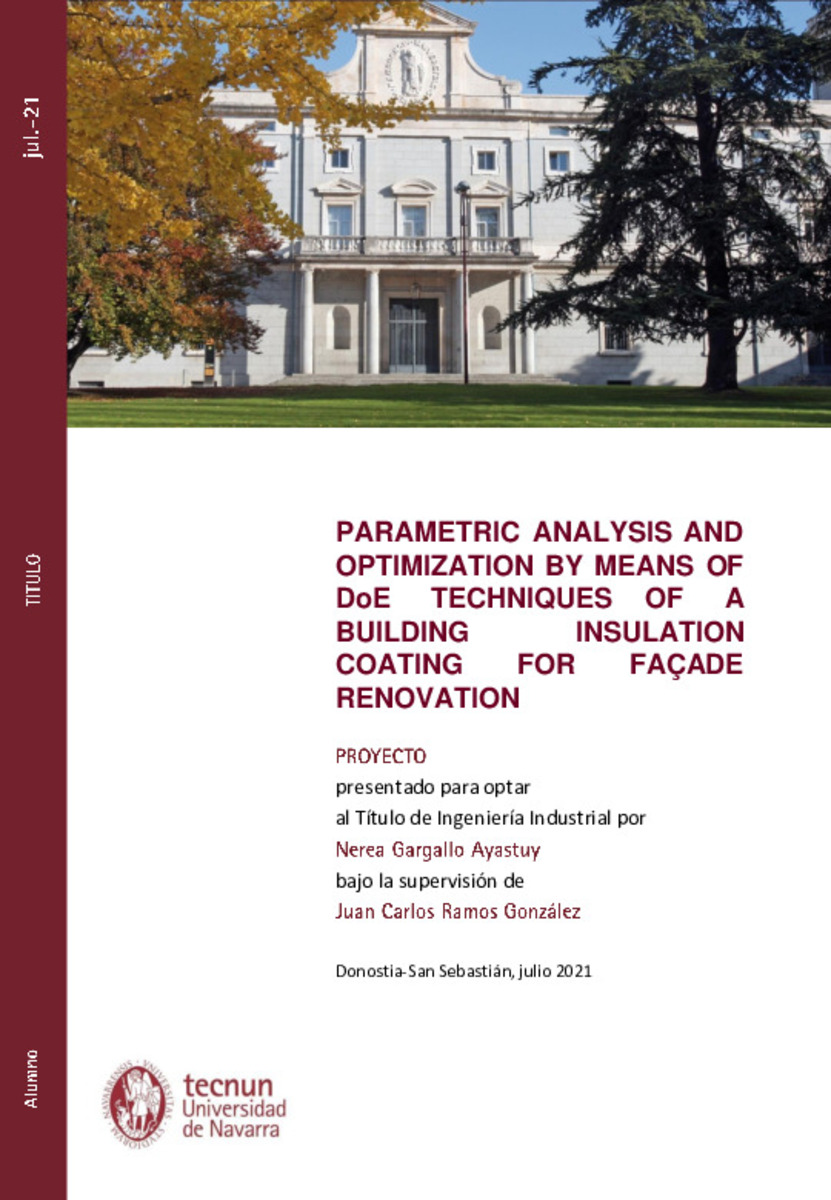Full metadata record
| DC Field | Value | Language |
|---|---|---|
| dc.contributor.advisor | Ramos-González, J. (Juan Carlos) | - |
| dc.creator | Gargallo Ayastuy, N. (Nerea) | - |
| dc.date.accessioned | 2022-06-21T07:08:33Z | - |
| dc.date.available | 2022-06-21T07:08:33Z | - |
| dc.date.issued | 2021-07 | - |
| dc.date.submitted | 2021-07-20 | - |
| dc.identifier.citation | GARGALLO, Nerea. "Parametric analysis and optimization by means of DoE techniques of a building insulation coating for façade renovation." Ramos, J.C.(dir.). Trabajo fin de grado. Universidad de Navarra, Pamplona, 2021 | es_ES |
| dc.identifier.uri | https://hdl.handle.net/10171/63679 | - |
| dc.description.abstract | The energetic performance of a building insulation coating is assessed by means of simulations of a dynamic RC model and by carrying out a parametric analysis based on Design of Experiment techniques. The external insulation coating is characterized by three parameters: the thermal conductive resistance, the shortwave solar absorptivity, and the longwave emissivity. The façade of the building is modelled with two lumped thermal capacitances on the internal and the external surfaces, and two thermal resistances representing the conduction through the wall and the internal convective and radiative phenomena. The external insulation is modelled by two more thermal resistances, which simulate the external convective exchanges and the conduction through the insulation, and one thermal capacitance in the insulation external surface. The inputs to the model are the external ambient temperature, the internal temperature, and the weather conditions (the wind convective heat transfer coefficient and the incident shortwave and the longwave radiative heat fluxes). The analyzed output parameters of the model are the internal surface heat flux and the solar collection at the external surface of the wall, which have a direct impact on the heating and cooling loads. After trying different DoE methods, the Box-Behnken Design has been used to select the optimal values of the parameters of the insulation coating that result in a maximized internal heat flux during winter months and a minimized flux during summer months. The analysis has been carried out for three different types of walls under the weather conditions of Bilbao (North of Spain). The use of the Box-Behnken Design permits to assess the combined effect of the input parameters on the output parameter and the formulation of a simplified compact model to predict the latter as a function of the formers. | es_ES |
| dc.language.iso | eng | es_ES |
| dc.publisher | Servicio de Publicaciones. Universidad de Navarra | es_ES |
| dc.rights | info:eu-repo/semantics/openAccess | es_ES |
| dc.subject | Energy efficiency. | es_ES |
| dc.subject | Building insulation coating. | es_ES |
| dc.subject | Passive systems. | es_ES |
| dc.subject | Optimization. | es_ES |
| dc.subject | Análisis paramétrico. | es_ES |
| dc.subject | Diseño de experimentos. | es_ES |
| dc.title | Parametric analysis and optimization by means of DoE techniques of a building insulation coating for façade renovation. | es_ES |
| dc.type | info:eu-repo/semantics/bachelorThesis | es_ES |
Files in This Item:
Statistics and impact
Items in Dadun are protected by copyright, with all rights reserved, unless otherwise indicated.






